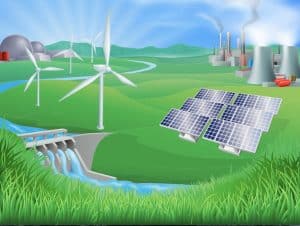
We often think of diesel as dirty, and view renewable microgrids as one way to eliminate the use of diesel and other fossil fuels. However, more and more, diesel-backed microgrids can be cleaner, if they rely on the newer, Tier-4 generators.
It all depends on where the power is needed, what fuels are available, and how much the microgrid owner or operator is willing to pay.
Tier-4 generators, introduced in 2014, use low-sulfur diesel, and generally carry about a 10 percent cost premium, said Allen Schaeffer, executive director of the Diesel Technology Forum, a non-profit advocacy group for diesel technology.
They’re definitely not emission-free, even though the industry tends to call them “near-zero” emission generators. They can reduce oxides of nitrogen and fine particulate emissions by about 90 percent compared to previous versions of the technology developed before the advent of emissions standards, said Sarah Dirndorfer, a spokeswoman for the Diesel Technology Forum.
Pollutants regulated
The key pollutants regulated from this type of engine include nitrogen oxide, particulate matter, sulfur dioxide, carbon monoxide and hydrocarbons, according the the EPA.
They have their place in microgrids because of their ability to provide power 24-7.
In order to take advantage of diesel generators’ ability to provide cleaner power, low-sulfur fuel must be available, which generally isn’t the case in Africa and India, for example.
A diesel-backed microgrid operated during Super Bowl 50 in San Francisco, Calif. Using Tier 4 technology, the microgrid powered Super Bowl City using renewable diesel fuel – as opposed to petroleum diesel fuel, said Dirndorfer. It’s not biodiesel, it’s Neste renewable diesel, created from renewable raw materials, including any organic biomass – vegetable oil, for example. Most of the renewable biodiesel comes from rapeseed oil or soybean oil.
Diesel can also be used to back up renewable microgrids, ensuring they run 24/7.
Pairing diesel and renewables
A National Renewable Energy Laboratory (NREL) publication points to the benefits of solar, battery and diesel microgrids, explaining that using solar PV allows diesel generators to turn off during the day. The battery can provide backup during the transition from diesel to solar and when there is cloud cover. And after diesel fuel is exhausted, the battery and solar can “support daytime loads indefinitely.”
Diesel is often seen as an important backup in renewable microgrids, said Schaeffer. “Everyone is beginning to recognize the fragility of the grid. Lights went out recently in Oregon during a snow storm, California has lost power due to fires,” he said. Reliable backup power is becoming increasingly important, he added.
“What diesel brings to the table is proven technology, a fueling and service network and often onsite maintenance people.” And if necessary, a diesel unit can be rented temporarily.
Depending on the applications, choosing diesel over natural gas as a backup source in microgrids offers some advantages, said Schaeffer. For example, operators don’t have to worry about gas pipeline interruptions due to earthquakes or natural disasters. And the diesel fuel can be stored on site.
“It can be expensive to generate prime power from diesel fuel with generators, but it can be done. But it’s more economic if you can generate half your electricity from wind or solar, save half on the fuel bill, and still have good grid power for reliability,” he said.
In this case, it’s not necessary to replace diesel generators with renewables, but to use renewable energy to supplement diesel, Schaeffer said. “The diesel is still the main backup.”
However, during emergencies, it’s not always easy to get access to diesel fuel once it runs out.
That’s one of the reasons the Clean Coalition and the World Business Academy are planning a series of community microgrids, based on renewable energy, for the city of Montecito, Calif., which has had to grapples with fires and storms. Many of the critical services use diesel; the plan is to use less diesel and more renewable energy.
With more communities like Montecito turning to microgrids, a number of diesel generator manufacturers are beginning to offer packages for diesel-based microgrids, said Schaeffer.
For example, Caterpillar’s Cat Microgrid System combines PV solar, energy storage and diesel or gas generation. The company says its system uses standardized building blocks that are easy to install, even in rugged environments.
How diesel-backed microgrids protect public health
Such diesel-backed microgrids help protect public health by providing continuous electric power, said Schaeffer.
“Without continuous power, there can be economic and health losses, contaminated food and waste in manufacturing,” he said. That’s why sewage and wastewater treatment plants often rely on backup diesel, he added.
“Having diesel as part of microgrids is the best of both worlds,” said Schaeffer. “You get the renewables you want with the reliability you need.”
